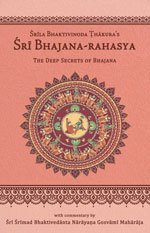Bhajana-Rahasya
by Srila Bhaktivinoda Thakura Mahasaya | 2010 | 123,965 words
The Bhajana-rahasya Text 34, English translation, including commentary (vritti). The Bhajana-rahasya is a compilation of verses describing the mercy of the eight pairs of names (Yugala-nama) of the Maha-mantra. This is text 34 belonging to the chapter “Prathama-yama-sadhana (Nishanta-bhajana–shraddha)” representing the last six dandas of the night: approximately 3.30 a.m.–6.00 a.m.
Text 34
Śrī Gopāla-guru Gosvāmī explains the meaning of the holy name as follows:
विज्ञाप्य भगवत्-तत्त्वं चिद्-घनानन्द-विग्रहम्
हरत्य् अविद्यां तत्-कार्यम् अतो हरिर् इति स्मृतः
हरति श्री-कृष्ण-मनः कृष्णाह्लाद-स्वरूपिणी
अतो हरेत्य् अनेनैव श्री-राधा परिकीर्तिता
आनन्दैक-सुख-स्वामी श्यामः कमल-लोचनः
गोकुलानन्दनो नन्दनन्दनः कृष्ण ईर्यते
वैदग्धी सार-सर्वस्वं मूर्ति-लीलाधिदैवतम्
राधिकां रम्यन् नित्यं राम इत्य् अभिधीयतेvijñāpya bhagavat-tattvaṃ cid-ghanānanda-vigraham
haraty avidyāṃ tat-kāryam ato harir iti smṛtaḥ
harati śrī-kṛṣṇa-manaḥ kṛṣṇāhlāda-svarūpiṇī
ato harety anenaiva śrī-rādhā parikīrtitā
ānandaika-sukha-svāmī śyāmaḥ kamala-locanaḥ
gokulānandano nandanandanaḥ kṛṣṇa īryate
vaidagdhī sāra-sarvasvaṃ mūrti-līlādhidaivatam
rādhikāṃ ramyan nityaṃ rāma ity abhidhīyateThe Supreme Person Śrī Bhagavān has descended in the form of the holy name, which is the embodiment of condensed knowledge and bliss. While remembering the name of Bhagavān, one should remember that nāma and nāmī are non-different. In the first stage of a sādhaka’s progress, the holy name removes ignorance. Therefore, He is Hari, ‘He who removes’. The rasika-ācāryas, however, taste harināma by thinking that in the kuñjas, Vṛṣabhānu-nandinī Śrī Rādhā is stealing away the mind of Śrī Hari by Her service. He who chants Hare Kṛṣṇa with this meditation attains prema-bhakti. Śrī Rādhā is kṛṣṇa-hlādinī-rūpiṇī, the embodiment of Kṛṣṇa’s own pleasure potency. She steals away Kṛṣṇa’s mind, and therefore, Her name is Harā. The vocative form of Harā is Hare. Thus, Hare Kṛṣṇa means the Divine Couple Śrī Rādhā-Kṛṣṇa.
The names Rādhā and Kṛṣṇa are sac-cid-ānanda, full of eternity, knowledge and bliss. Rādhā and Kṛṣṇa are personally present in Hare Kṛṣṇa. The eternal master of Śrī Rādhā, who is bliss personified, is Śyāma, who has eyes like lotus petals and who desires that Śrī Rādhikā is always happy. Nanda-nandana Śrī Kṛṣṇa, the giver of bliss to the residents of Gokula, is always yearning to taste happiness with Śrī Rādhā. Kṛṣṇa is Līleśvara, a clever dhīra-lalita-nāyak[1]; therefore, His name is Rādhā-ramaṇa. The Hare Kṛṣṇa mahā-mantra is comprised of names of the Divine Couple. While chanting this mantra one should remember Their pastimes.
चिद्-घन आनन्द-रूप श्री-भगवान्
नाम-रूपे अवतार एइ त प्रमाणcid-ghana ānanda-rūpa śrī-bhagavān
nāma-rūpe avatāra ei ta pramāṇaअविद्या-हरण कार्य हैते नाम हरि
अतएव हरे कृष्ण नामे याय तरिavidyā-haraṇa kārya haite nāma hari
ataeva hare kṛṣṇa nāme yāya tariकृष्णाह्लाद-स्वरूपिणी श्री-राधा आमार
कृष्ण मन हरे ताइ हरा नाम ताङ्रkṛṣṇāhlāda-svarūpiṇī śrī-rādhā āmāra
kṛṣṇa mana hare tāi harā nāma tāṅraराधा-कृष्ण शब्दे श्री-सच्-चिद्-आनन्द रूप
हरे कृष्ण शब्दे राधा-कृष्णेर स्वरूपrādhā-kṛṣṇa śabde śrī-sac-cid-ānanda rūpa
hare kṛṣṇa śabde rādhā-kṛṣṇera svarūpaआनन्द-स्वरूप-राधा ताङ्र नित्य स्वामी
कमल-लोचन श्याम राधानन्द-कामीānanda-svarūpa-rādhā tāṅra nitya svāmī
kamala-locana śyāma rādhānanda-kāmīगोकुल-आनन्द नन्द-नन्दन श्री-कृष्ण
राधा-सङ्गे सुखास्वादे सर्वदा सतृष्णgokula-ānanda nanda-nandana śrī-kṛṣṇa
rādhā-saṅge sukhāsvāde sarvadā satṛṣṇaवैदग्ध्य-सार-सर्वस्व मूर्त लीलेश्वर
श्री-राधा-रमण राम नाम अतःपरvaidagdhya-sāra-sarvasva mūrta līleśvara
śrī-rādhā-ramaṇa rāma nāma ataḥparaहरे कृष्ण महा-मन्त्र श्री-युगल नाम
युगल लीलार चिन्ता कर अविरामhare kṛṣṇa mahā-mantra śrī-yugala nāma
yugala līlāra cintā kara avirāma
Commentary: Bhajana-rahasya-vṛtti:
Śrī Kṛṣṇa is the personification of condensed eternity, knowledge and bliss (sac-cid-ānanda). He is an ocean of compassion. The clear proof of this is that He has appeared on this Earth in the form of His name for the benefit of the living entities. This form of Śrī Hari is performing the task of removing ignorance. Therefore, those who affectionately chant harināma are saved from this illusory world, which is the product of ignorance.
Śrī Rādhā is the essence of the hlādinī-śakti, and She is always giving supreme pleasure to Svayam Bhagavān Śrī Kṛṣṇa. She even steals away the mind of parama-puruṣa Śrī Kṛṣṇa with Her sweet form and qualities and by Her prema-filled service. Therefore, one of Her names is Harā. ‘Hare’ in the mahā-mantra is the vocative form of Harā, which refers to Śrī Rādhā. Thus, the devotee who is exclusively committed to the Divine Couple (the aikāntika-bhakta ) accepts Rādhā-Kṛṣṇa as the only meaning of Hare Kṛṣṇa. Śrī Rādhā is the personification of bliss (ānanda-svarūpiṇī). Kamala-locana Śyāmasundara is Her eternal beloved. He is always intent on pleasing Śrī Rādhā, but He nonetheless remains indebted to Her. The source of the great festival of bliss of Gokula, Nanda-nandana, is the supremely attractive attractor. Therefore, He is named Kṛṣṇa. Even though He always tastes happiness in Śrī Rādhā’s association, He is never satiated and is ever eager for more. He is famous as Rādhāramaṇa because He, Līleśvara, the personification and essence of all vaidagdhya (cleverness in amorous pastimes), is always with Śrī Rādhā, playing (ramaṇa ) inside and outside Her heart. This Rādhāramaṇa Śrī Kṛṣṇa is called Rāma in the mahā-mantra. It should be understood that Hare Kṛṣṇa in the mahā-mantra means Rādhā Kṛṣṇa Yugala. Therefore, while performing japa or kīrtana of the mahā-mantra, one should continuously remember the pastimes of the Divine Couple Śrī Rādhā-Kṛṣṇa.
